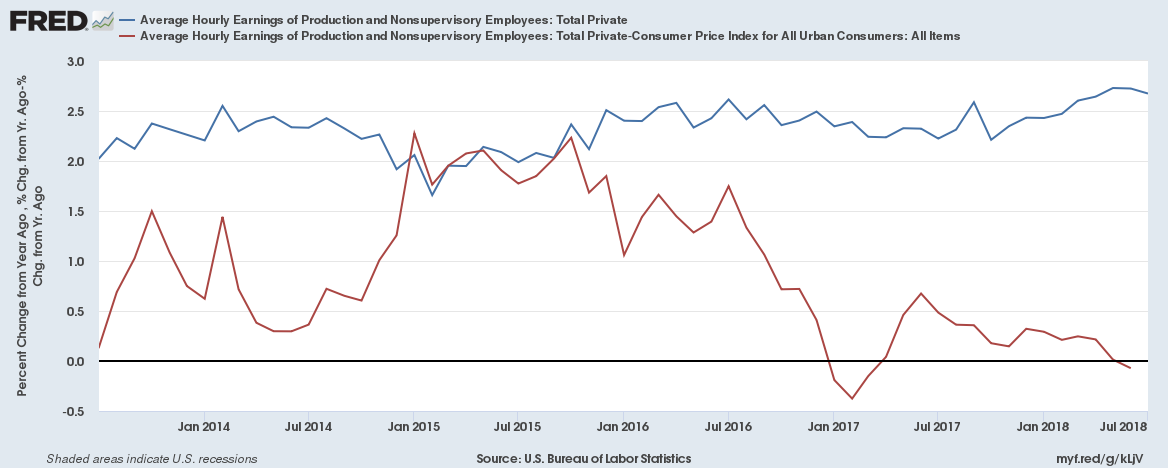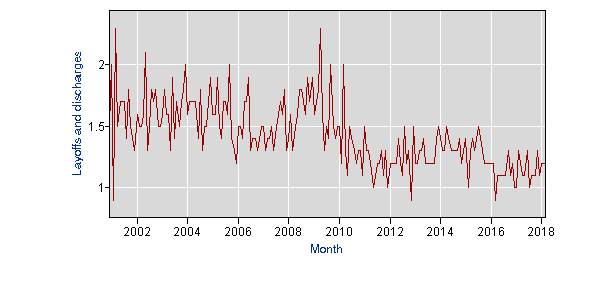May 09, 2018
The Bureau of Labor Statistics released data from its March Job Openings and Labor Turnover Survey (JOLTS) yesterday. It got some attention because the job openings figure rose substantially, bringing the job opening rate to 4.3 percent, the highest since the survey was first fielded in December of 2000. This is somewhat higher than the 3.7 percent hire rate. Since the hiring rate had previously exceeded the job opening rate, as seen below, this was taken as fresh ammunition by the “hard to get good help” gang.

The argument they are making is that businesses have jobs open and want to hire, but they just can’t find the people with the right skills. The problem with this story is that we see a sharp rise in the ratio of openings to hires everywhere, including industries like retail trade and restaurants, where we generally don’t think of as requiring high skills.
In 2007, before the Great Recession, the job opening rate in retail was 2.6 percent. The hiring rate was 4.9 percent, a gap of 2.3 percentage points. In March, the job opening rate was 4.3 percent with a hiring rate of 4.4 percent, a gap of just 0.1 percentage point.
There is a similar story with the restaurant sector (actually accommodation and food service). In 2007, the job opening rate was 4.4 percent. The hire rate was 6.9 percent, for a gap of 2.5 percentage points. In the most recent data, the job opening rate was 5.4 percent, while the hiring rate was 6.1 percent, a gap of 0.7 percentage points.
Between 2007 and March of 2018, the gap between hiring rates and openings fell by 2.2 percentage points in retail and 1.8 percentage points in restaurants. This compares to an overall decline in the size of the gap of 1.1 percentage points (and a shift in direction). In short, the rise in job opening relative to hires was sharper in retail trade and restaurants than in the economy as a whole.
This doesn’t fit well with the lack of qualified workers story unless the skills required to get a job in these sectors are much higher than is generally believed.
It is also interesting that turnover, in general, is lower today than before the recession, mostly because of a decline in layoffs and discharges. In 2007, the layoff and discharge rate averaged 1.5 percent in the private sector. In March it was just 1.2 percent. This decline appears to be pretty much across the board. The figure below shows the story for retail since 2000.
Layoff and Discharge Rate in Retail Industry

Source: Bureau of Labor Statistics.
By contrast, at 2.5 percent in March, the quit rate was slightly higher than its 2.4 percent rate for 2007. But it was still well below the 2.9 percent rate for January of 2001, just before the recession hit in March of that year.
It is not clear what to make of the rise in openings relative to hires. Perhaps businesses are being more picky about who they hire or perhaps they are listing jobs that they are not in a hurry to fill. The skills shortage does not fit in any easy way since we see this rise even in sectors where most of the jobs require few skills.
The decline in the layoff and discharge rate is striking. It goes in the opposite direction of much of the popular discussion about rapid technological change transforming the workplace. (It is consistent with the slow productivity growth we have been seeing.)
The rise in the quit rate is a positive, suggesting workers are feeling more comfortable about their labor market prospects, but they are still noticeably less willing to quit than in the few months for which we have data, just before the 2001 recession. In other words, by this measure, we have some way yet to go before we are back in the 2000 labor market.







Comments